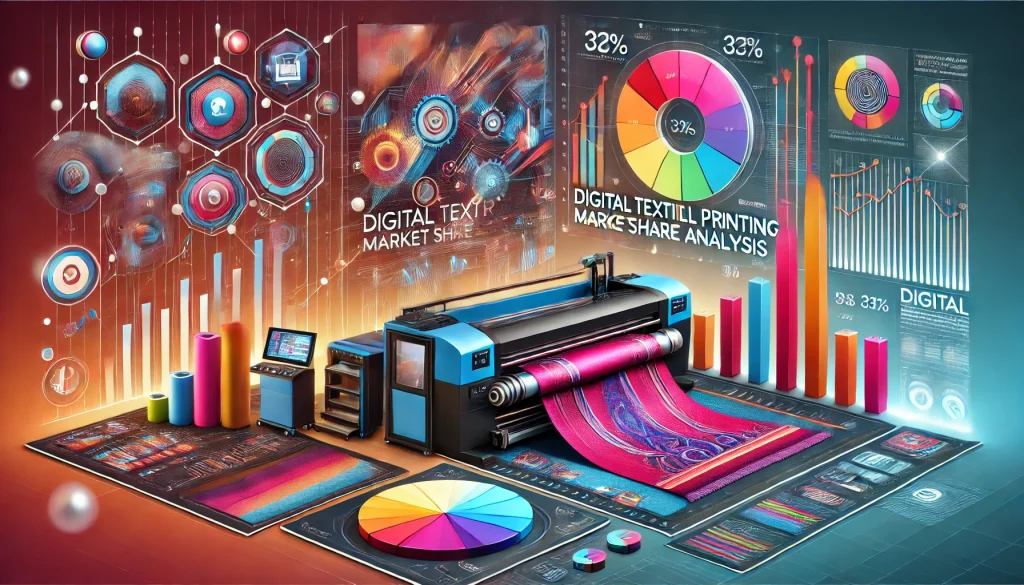
The global digital textile printing market share analysis is expanding as businesses recognize the value of on-demand, high-quality printing with minimal environmental impact. With advancements in digital printing technology and the development of high-performance inks, manufacturers can achieve enhanced productivity while reducing waste.
Digital textile printing is a cutting-edge technology that applies digital inkjet printing techniques to textiles, offering a more flexible and sustainable alternative to traditional textile printing methods such as screen printing. This process allows for high-resolution designs, rapid prototyping, and customized production, making it a preferred choice for the fashion, home décor, and industrial fabric sectors.
Explore Opportunities – Get Your Sample of Our Industry Overview Now!
https://www.futuremarketinsights.com/report-sample#5245502d47422d2e3230323931
The digital textile printing market is undergoing a revolutionary transformation, with advancements in technology, sustainability, and consumer-driven demand reshaping the industry. As businesses increasingly adopt digital printing solutions, the sector is witnessing a shift toward high-performance, cost-efficient, and eco-friendly production methods.
Market Demand and Growth Drivers
The increasing adoption of digital textile printing is driven by several factors, including:
- Personalization and Customization – Consumers demand unique, personalized textiles, from fashion apparel to home furnishings. Digital printing allows for short production runs, reducing inventory risks while meeting diverse customer preferences.
- Sustainability Initiatives – Traditional textile printing processes consume large amounts of water and generate significant waste. Digital printing significantly reduces water usage, ink consumption, and fabric wastage, aligning with global sustainability goals.
- Rapid Production Cycles – The shift toward fast fashion and quick-response manufacturing requires textile printers to produce high-quality prints quickly. Digital textile printing accelerates turnaround times, meeting the growing demand for just-in-time manufacturing.
- Advancements in Ink Technology – The development of eco-friendly, high-performance inks (such as pigment, reactive, and sublimation inks) enhances color vibrancy, durability, and adherence to sustainability standards, making digital textile printing a viable option for mass production.
- Integration with Smart Technologies – The adoption of AI-driven design software, automation, and IoT-enabled monitoring in textile printing is boosting efficiency and precision, reducing material wastage and operational costs.
Emerging Trends in Digital Textile Printing Market Share Analysis
Several trends are shaping the digital textile printing landscape:
- Sustainable and Waterless Printing – With environmental concerns at the forefront, manufacturers are investing in waterless printing techniques, such as pigment-based digital printing, which eliminates the need for excessive water consumption.
- Hybrid Printing Technologies – A combination of digital and screen printing is gaining traction to enhance efficiency, maintain traditional aesthetics, and reduce costs.
- Smart Textiles and Functional Fabrics – Digital printing is increasingly used in the production of smart textiles, including fabrics with embedded sensors, temperature-sensitive dyes, and conductive materials for wearable technology.
- E-commerce and Print-on-Demand Services – The growth of online fashion and home décor businesses has fueled demand for print-on-demand textile solutions, enabling brands to produce limited-edition designs without overproduction risks.
- Expansion into Industrial Applications – Beyond fashion and home textiles, digital printing is being widely adopted in automotive textiles, sportswear, and medical fabrics, creating new revenue streams for manufacturers.
Expansion of Digital Textile Printing in Home Furnishing and Interior Decor
Beyond the fashion sector, digital textile printing is making remarkable strides in home furnishings and interior decor. Consumers are embracing customized upholstery, curtains, bed linens, and wall coverings that reflect personal aesthetics. The ability to print intricate patterns and detailed designs on diverse textiles has enabled interior designers and home decor brands to offer exclusive, high-quality products.
Competitive Landscape
The digital textile printing industry is highly competitive, with key players focusing on innovation, sustainability, and strategic partnerships. Major companies operating in the market include:
- Kornit Digital – A leader in sustainable direct-to-garment (DTG) and direct-to-fabric (DTF) printing solutions, emphasizing waterless technology.
- Epson – Known for its high-performance SureColor series, offering precision and efficiency in textile printing.
- Mimaki – Specializing in sublimation and pigment-based printing solutions for fashion and industrial textiles.
Digital Textile Printing Market Share Analysis Segmentation
By End-User:
- Fashion
- Home Textiles
- Industrial Textiles
By Region:
- North America
- Europe
- Asia-Pacific
- Other Regions
About Future Market Insights (FMI)
Future Market Insights, Inc. (ESOMAR certified, recipient of the Stevie Award, and a member of the Greater New York Chamber of Commerce) offers profound insights into the driving factors that are boosting demand in the market. FMI stands as the leading global provider of market intelligence, advisory services, consulting, and events for the Packaging, Food and Beverage, Consumer Technology, Healthcare, Industrial, and Chemicals markets. With a vast team of over 400 analysts worldwide, FMI provides global, regional, and local expertise on diverse domains and industry trends across more than 110 countries.
Contact Us:
Future Market Insights Inc.
Christiana Corporate, 200 Continental Drive,
Suite 401, Newark, Delaware – 19713, USA
T: +1-347-918-3531
For Sales Enquiries: sales@futuremarketinsights.com
Website: https://www.futuremarketinsights.com
LinkedIn| Twitter| Blogs | YouTube


